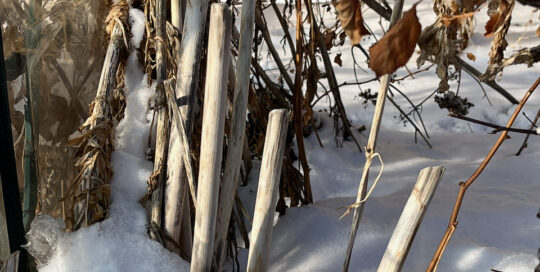Battling Bindweed
Views: 3761

Although it doesn’t fly or burrow into plants, I have to say field bindweed is one of the worst nuisances any of us could experience in the garden.
As a matter of fact, bindweed is so bad it’s forcing organic farmers to turn to chemicals to gain a handle on the problem.
I wrote an article, Where Have the Grain Growers Gone, for the Montana Organic Association because Montana lost over 32 thousand acres of organic grain production over the past couple of years. People wanted to know why. After talking to a number of growers, including those who’ve been in the organic program for decades, one of the biggest reasons was bindweed. One of the farmers I talked to for the piece said he took a look at his farm via Google Earth, and could see the bindweed in the fields. That was the clincher. After over 20 years of growing without chemicals, he decided there was no other way.
Out-of-Control Bindweed
We’re finding a similar problem in the community gardens. At the one at the University of Great Falls the bindweed is the bane of all of the gardeners there. Despite trying to stay on top of it, many simply gave up. Of course this made the problem worse. To try to save the garden (without chemical means) we’re going to cover the bulk of it with a 6 mm black plastic, and leave it over the garden for 3 years.
That’s the thing with bindweed; it’s not an easy thing to eradicate. The roots reach 20 feet deep, and will spread just as far horizontally. If you weed out every visible piece of it, it will be back the next day. It’s in the morning glory family, and has a pretty little pink or white flower. That’s where anything positive to say about it ends.
Bindweed grows exponentially during the warm months, and it entwines everything. Trying picking this nasty weed out of the shrub rose bushes. It isn’t fun.
Smothering Out Bindweed with Plastic
Theoretically, you can keep after bindweed and eventually weaken the plant to the point it will die, but I’m not sure if that necessarily means it’ll happen in your generation. I keep after mine, but it doesn’t show many signs of distress.
That’s where smothering it out with plastic can help. Most perennial weeds take about a year to “cook” out underneath plastic. Since the roots of bindweed go so deep, it takes 3 to 5 years. This is why we’re opting for the heavier plastic. We want it to stay in place without breaking down due to the sun and relentless wind. We’ll weight it down along the perimeter with a solid line of rocks to prevent it from blowing up and to keep it as tight to the ground as possible.
Chemical Sprays for Bindweed
If bindweed is the bane of your existence, and you have to resort to chemical means, you need to be smart about when you apply it. Glyphosate does the trick. Don’t spray it in spring. You’ll singe the tender new leaves and growth, but you won’t kill the mother plant. (Yes, this is a bit like fighting the antagonist in the “Alien” series. This thing doesn’t stop.)
To effectively spray bindweed, wait until the end of the season when the nights are starting to chill off, but the plant is still growing. The plant is drawing nutrients into the roots preparing for winter so if you spray it will pull the poison into the roots. Voila. Dead plant.
The reason we’re not spraying at the community garden is partly because the gardeners there want to keep it an organic garden. The other challenge is the best time to spray is when the garden is in full production. Even if we painted the leaves, it would still be nasty to have the poison so close to the good veggies.
Yes, bindweed is probably the absolute worst weed that’s out there in my book. If it’s not on your list, I’d really like to know what weed makes you twitch?
Meet Amy Grisak
Amy is a freelance author and photographer in Great Falls, MT who specializes in gardening, foods, and sustainable agriculture. She provides information on every kind…
Amy's Recent Posts

This Little Piggy is a Problem: Dealing with Feral Hogs








